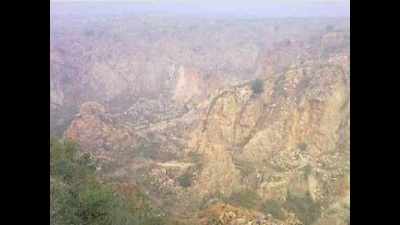- News
- City News
- gurgaon News
- Aravalli wildlife census report soon
Trending
This story is from July 21, 2016
Aravalli wildlife census report soon
The Wildlife Institute of India (WII), Dehradun, which has carried out a survey of wildlife in the Aravalis, is likely to come up with its report soon.

TOI image
GURGAON: The Wildlife Institute of India (WII), Dehradun, which has carried out a survey of wildlife in the Aravallis, is likely to come up with its report soon.
During the survey, sources said, the presence of major wildlife species, including leopard was found in Mangarbani. Marks of other animals like hyena, nilgai and mongoose were also spotted.
The WII conducted a survey through February to June, and is expected to submit its report to the forest department soon. Apart from assessing the presence of wildlife population in the area, the survey has also tried to map the land use and land cover pattern of the Aravalli.
"The survey report will help the forest department and state government identify areas important for conservation and protection of wildlife and their habitat in Aravalli," said a forest official. He said the WII team is expected to hold a meeting with department next week.
Using the trail method to trace the species, WII has recorded pug marks and droppings to estimate their number and preferable habitat in Aravalli. Along with counting the number of species, the survey has also tried to estimate prey species. It has also recorded areas which are under dense forests, grassland and other kind of vegetation. The exercise to track the wildlife was carried out in five districts in the Haryana.
During the survey, pug marks of leopard and a cub was found in Mangarbani. Pugmarks of leopard were also found in Mohbatabad and Shilkhri area. The survey team claims to have found ample evidence of wildlife in the region, including a 2.5 km long trail of leopard pugmarks around Damdama Lake, and hyena pugmarks. Tracks of mongoose, jackal and nilgai were also found in the area. Some unidentified pugmarks believed to be that of the Indian fox - which is rare in this region - were also found.
During the survey, sources said, the presence of major wildlife species, including leopard was found in Mangarbani. Marks of other animals like hyena, nilgai and mongoose were also spotted.
The WII conducted a survey through February to June, and is expected to submit its report to the forest department soon. Apart from assessing the presence of wildlife population in the area, the survey has also tried to map the land use and land cover pattern of the Aravalli.
"The survey report will help the forest department and state government identify areas important for conservation and protection of wildlife and their habitat in Aravalli," said a forest official. He said the WII team is expected to hold a meeting with department next week.
"We have completed our survey and are now analysing the data. We will share the data with forest department for verification before coming up with final conclusion and publication of final report," said Bilal Habib, WII project head.
Using the trail method to trace the species, WII has recorded pug marks and droppings to estimate their number and preferable habitat in Aravalli. Along with counting the number of species, the survey has also tried to estimate prey species. It has also recorded areas which are under dense forests, grassland and other kind of vegetation. The exercise to track the wildlife was carried out in five districts in the Haryana.
During the survey, pug marks of leopard and a cub was found in Mangarbani. Pugmarks of leopard were also found in Mohbatabad and Shilkhri area. The survey team claims to have found ample evidence of wildlife in the region, including a 2.5 km long trail of leopard pugmarks around Damdama Lake, and hyena pugmarks. Tracks of mongoose, jackal and nilgai were also found in the area. Some unidentified pugmarks believed to be that of the Indian fox - which is rare in this region - were also found.
End of Article
FOLLOW US ON SOCIAL MEDIA










